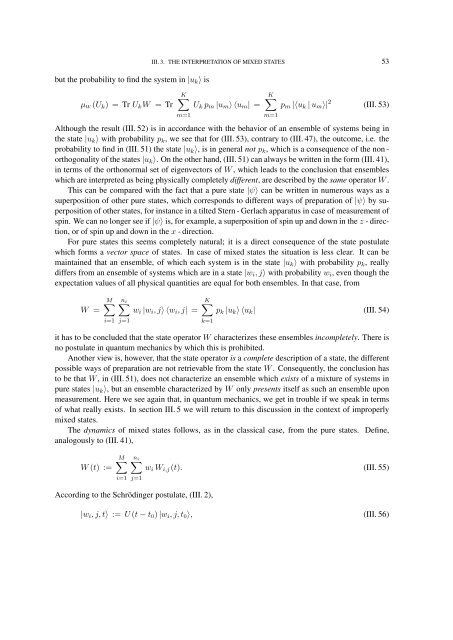FOUNDATIONS OF QUANTUM MECHANICS
FOUNDATIONS OF QUANTUM MECHANICS
FOUNDATIONS OF QUANTUM MECHANICS
Create successful ePaper yourself
Turn your PDF publications into a flip-book with our unique Google optimized e-Paper software.
ut the probability to find the system in |u k ⟩ is<br />
µ W (U k ) = Tr U k W = Tr<br />
III. 3. THE INTERPRETATION <strong>OF</strong> MIXED STATES 53<br />
K∑<br />
m=1<br />
U k p m |u m ⟩ ⟨u m | =<br />
K∑<br />
m=1<br />
p m |⟨u k | u m ⟩| 2 (III. 53)<br />
Although the result (III. 52) is in accordance with the behavior of an ensemble of systems being in<br />
the state |u k ⟩ with probability p k , we see that for (III. 53), contrary to (III. 47), the outcome, i.e. the<br />
probability to find in (III. 51) the state |u k ⟩, is in general not p k , which is a consequence of the non -<br />
orthogonality of the states |u k ⟩. On the other hand, (III. 51) can always be written in the form (III. 41),<br />
in terms of the orthonormal set of eigenvectors of W , which leads to the conclusion that ensembles<br />
which are interpreted as being physically completely different, are described by the same operator W .<br />
This can be compared with the fact that a pure state |ψ⟩ can be written in numerous ways as a<br />
superposition of other pure states, which corresponds to different ways of preparation of |ψ⟩ by superposition<br />
of other states, for instance in a tilted Stern - Gerlach apparatus in case of measurement of<br />
spin. We can no longer see if |ψ⟩ is, for example, a superposition of spin up and down in the z - direction,<br />
or of spin up and down in the x - direction.<br />
For pure states this seems completely natural; it is a direct consequence of the state postulate<br />
which forms a vector space of states. In case of mixed states the situation is less clear. It can be<br />
maintained that an ensemble, of which each system is in the state |u k ⟩ with probability p k , really<br />
differs from an ensemble of systems which are in a state |w i , j⟩ with probability w i , even though the<br />
expectation values of all physical quantities are equal for both ensembles. In that case, from<br />
W =<br />
M∑<br />
i=1<br />
∑n i<br />
j=1<br />
w i |w i , j⟩ ⟨w i , j| =<br />
K∑<br />
p k |u k ⟩ ⟨u k | (III. 54)<br />
k=1<br />
it has to be concluded that the state operator W characterizes these ensembles incompletely. There is<br />
no postulate in quantum mechanics by which this is prohibited.<br />
Another view is, however, that the state operator is a complete description of a state, the different<br />
possible ways of preparation are not retrievable from the state W . Consequently, the conclusion has<br />
to be that W , in (III. 51), does not characterize an ensemble which exists of a mixture of systems in<br />
pure states |u k ⟩, but an ensemble characterized by W only presents itself as such an ensemble upon<br />
measurement. Here we see again that, in quantum mechanics, we get in trouble if we speak in terms<br />
of what really exists. In section III. 5 we will return to this discussion in the context of improperly<br />
mixed states.<br />
The dynamics of mixed states follows, as in the classical case, from the pure states. Define,<br />
analogously to (III. 41),<br />
W (t) :=<br />
M∑<br />
i=1<br />
∑n i<br />
j=1<br />
w i W i,j (t). (III. 55)<br />
According to the Schrödinger postulate, (III. 2),<br />
|w i , j, t⟩ := U (t − t 0 ) |w i , j, t 0 ⟩, (III. 56)
















